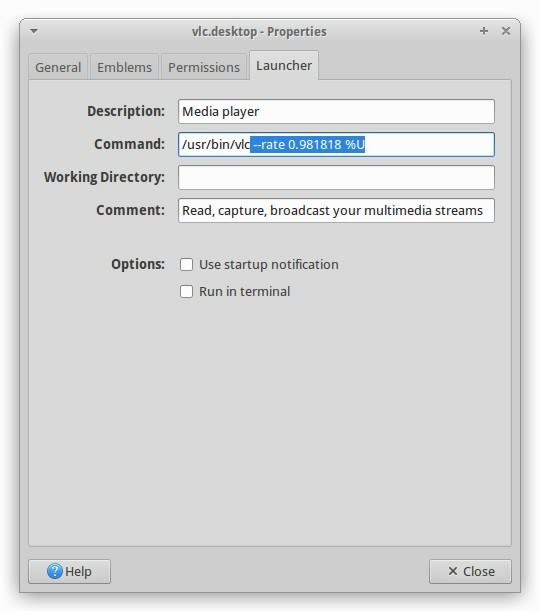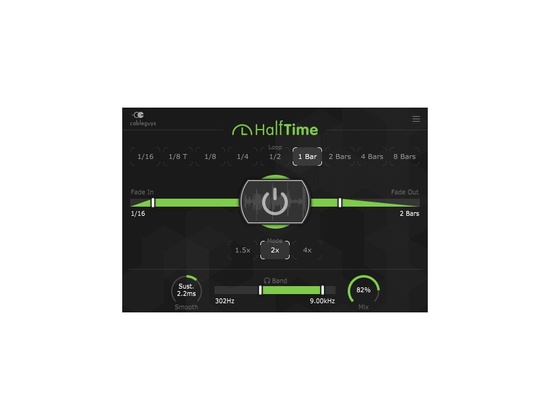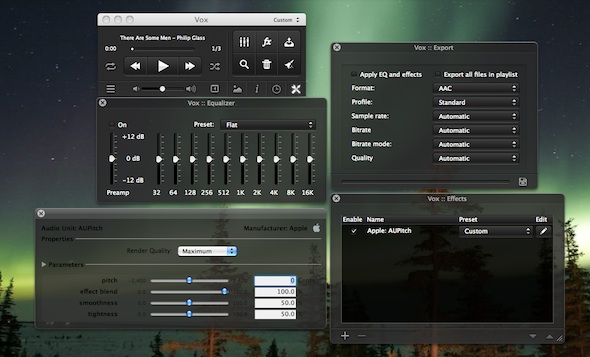Vlc Pitch Shift Plugin
VLC Media Player has several controls that can be used to control the volume of a playing media file. There are on-screen volume controls which you can slide up and down using the mouse to increase and decrease the volume. There also are hotkeys or shortcuts which can be used to easily control the volume straight from the keyboard. Similar controls for muting and unmuting the audio or setting it as stereo, mono, left, right or reverse stereo are also present. There are also options to disable the audio completely in an accompanying video. It is also possible to select the right audio in a video with multiple soundtracks and we can choose the correct audio output module if we have laptop speakers along with external speakers and earphones/headphones connected. Finally, we also found controls to remember the volume level settings and some additional effects which are built for the advanced users. We will talk about those audio controls to help you maintain a desired volume and sound effects at all times when playing media through VLC.
The Basics of Audio in VLC
On-Screen Volume Controls
On the bottom-right corner of the interface, there is the volume widget. The mouse or trackpad on your laptop can be used to reach that area to click and drag the volume level. We can make it go from 0% to 125%. Also, clicking on the volume icon will allow us to mute and unmute the player. This is the simplest way to control sound levels in VLC Media Player. The location of the volume icon can be edited by customizing the interface.
Menu Controls for Audio
VLC 3.0 'Vetinari' is a new major update of VLC. VLC 3.0 activates hardware decoding by default, to get 4K and 8K playback! It supports 10bits and HDR. VLC supports 360 video and 3D audio, up to Ambisonics 3rd order. Allows audio passthrough for HD audio codecs. Oct 17, 2020 the pitch shifter is a plugin (scaletempopitch), libvlc doesn't provide an API to manipulate filter directly, you need to add them to your input, with something like-audio-filter=scaletempopitch -pitch-shift=5. May 27, 2013 I do have a program to pitch shift audio, but it's so very useful to see the video simultaneously to hearing the audio. Alas, at the moment I don't have a way to hear pitch shifted audio simultaneously to seeing the video. Bonus points if VLC could REMEMBER the designated pitch shift PER VIDEO between launches. But I'd settle for the core feature. I was searching for a specific version of vlc that had those options, i found it at the end, it’s the 3.0.8 Vetinari version that has the function i was looking for. In advanced, this version has a pitch modification option that allows for pitch shift with altering the length of the audio.
The menu bar on top or the right-click options has a top-level menu called Audio which gives access to features that can be used for volume controls with some additional options. Here are what they are:
- Audio Track. Choose one between multiple tracks (Track 1, Track 2) or Disable it completely.
- Audio Device. Pick the default playback device if there are multiple speakers or earphones connected.
- Stereo Mode. Pick Mono, Stereo, Left, Right and Reverse stereo.
- Visualizations. Pick a visualization for the audio playback and advanced users can install custom ones.
- Increase, Decrease Volume and Mute. These are self-explanatory. We can make the sound go up, down or turn it off.
Hotkeys/Shortcuts for Audio
To save time or for our convenience, we can use keyboard buttons for volume controls in VLC Media Player. Such keyboard controls are called hotkeys in VLC. By default, we can use CTRL + Up Arrow or CTRL + Down Arrow to increase and decrease the volume respectively. The ‘M’ shortcut key can be pressed to mute or unmute the media. The J and K keys are for decreasing and increasing the audio delay by 50ms at a time. These hotkeys are configurable and we can change them to our liking. It is much quicker to use hotkeys in VLC Media Player.

Note: When a media file is open, using the hotkey, the audio can go up to a maximum of 200% but we have to be careful to not set it too high that our laptop speakers cannot handle it and our speakers might get damaged.
Fixing Audio Synchronization (or Delay)
Sometimes, the audio doesn’t line up with the video. When it is out of sync, we can slow down the audio or move forward by certain seconds. This will make sure that the audio is synchronized with the video.
- To delay the audio by 50 milliseconds press K on the keyboard. The screen will display Audio delay 50 ms.
- To advance the audio by 50 milliseconds press J on the keyboard. The screen will display Audio delay -50 ms.
Tap on the J and K keys repetitively until the synchronization issue has been fixed.
Audio options for Intermedia Users
Simple Audio Preferences
Now, let us move to the audio options available in the simple preferences.
To go to the audio options in simple preferences:
- Click on Tools > Preferences [CTRL + P]
- Go to the Audio tab
Under this tab, there are several options to manage the audio.
- ☑ Enable audio. It is checked by default and if the checkmark is removed and saved, the audio stream isn’t opened. It has to be checked again to enable the audio.
- Always reset audio start level to. Enable it and it makes it possible to set a default level of audio. Set it between 0% – 125% but a level of 80% – 100% seems like the optimum value.
- Output model. Default option i.e. Automatic is always fine. Additional options are:
- Windows multimedia device output,
- DirectX audio output,
- WaveOut audio output,
- Audio memory output,
- File audio output,
- Dummy audio output, and
- Disable.
- HDMI/SPDIF audio passthrough. It is disabled by default. We can Enable it for just AC3/DTS only or Enable it. Use the values to fix issues with HD codecs when using a HDMI receiver.
- Device. Choose a default output device. If you have an earphone plugged in, it will be the default device. If we select our speakers as the default output device, even though we might have the headphones connected, our speakers should play the sound.
- ☑ Enable time stretching audio. Keep it enabled to maintain the pitch of the sound when playing the video and audio or just audio slower or faster than its normal speed.
- ☑ Normalize volume to. Enter a value to set the value of the volume.
- Replay gain mode. Select the replay gain mode between none, track and album.
- Visualization. Choose an inbuilt audio visualization or for advanced users, install new visualizations.
- Preferred audio language. If the audio in a video has multiple tracks like in English, Hindi, German, we can set the default one that VLC picks. Enter values like en, in, de, jp which are actually alphabetical country codes.
- ☑ Submit played tracks stats to last.fm. Many would find this option useless.
Hitting Save is mandatory after we have made the changes and we want them to last.
Audio Effects
Several audio effects are available to make the sound output just right. We can find the equalizer, compressor, and many more under Audio Effects. One would use such effects like the equalizer, compressor, and spatializer to choose a preset and make a song sound good. There’s also the “Stereo Widener” and “Advanced” to adjust the pitch of the voices.
To access audio effects:
- Go to Tools > Effects and Filters.
- The Audio Effects tab is the first one.
- Navigate the Equalizer, Compressor, Spatializer, Stereo Widener and Advanced tab.
- ☑ Enable each one and drag the sliders.
- Hit Save to keep the effects.
One great use of the Compressor is to fix the sudden loud music for action scenes and low volume for the dialogues issue.
Audio Options for Advanced Users
Advanced Audio Preferences
What we talked about before is just the ‘tip of the iceberg’ of the audio settings that VLC has. It is enough for most of the users. Most would just be satisfied with the volume levels and having the option to select the audio language. The ‘Advanced Preferences for Audio’ are for professional users who have to dig into the specifics to get the right sound feedback. This is where every imaginable VLC settings for Audio are present.
To get to VLC’s advanced preferences for audio:
- Go to Tools > Preferences [CTRL + P].
- In the bottom, under show settings, click on All.
- Click on Audio for the General audio settings.
- There are various sub-items and sub-sub-items under it
- Audio Sampler. For the Audio filters that are used to process the audio stream.
- Filters. Check and activate the audio filter.
- Output modules. Select an audio output module and a media role.
- Visualizations. Choose a visualization and configure it.
Audio resampler
There are two sub-items under it.
- Speex resampler. Set the resampling quality.
- SRC resampler. Set the sample rate converter type like Sinc function, zero order hold or linear.
Filters
A range of filters is available for the advanced audio engineers and sound technicians. Several filters are available and can be activated. ☑ Check one or more than one to use them:
- Simple stereo widening effect. Enhance the stereo effect by suppressing mono.
- Ambisonics renderer and binauralizer. Add audio post-processing filters to modify the sound rendering.
- Pitch Shifter. Enable the pitch shifter.
- Parametric Equalizer. Alter a specific part of the frequency range.
- Stereo to mono downmixer. Convert stereo track to mono.
- Headphone virtual spatialization effect. Make any music format sound like you are listening to 7.1 surround sound.
- Equalizer with 10 bands. A 10-band equalizer for your sound.
- Sound delay. Add delay effects to sound.
- Audio Spatializer. The same spatializer from the audio effects menu. Music, Audio tempo scaler synched with rate: Change the tempo.
- Audio channel remapper. Switch right and left speakers or any others.
- Volume normalizer. For bringing down high volume audios.
- Simple Karaoke filter. Bring down the vocals.
- Gain control filter. Automatically adjust the gain to a suitable level.
- Dynamic range compressor. Reduce loud sounds and amplify the soft ones.
- Audio part of the BarGraph function.
Once activated, the filters can be configured through the sub-menu items available under filters. For example: After activating the Parametric Equalizer, we can go to Audio > Filters > Parametric Equalizer and change the values for the several rows of frequency and their gain. The filters that are available in the sub-menu are listed as Audio pitch changer, Audiobar Graph, Compressor, Delay, Equalizer, Gain, Headphone Effect, Mono, Parametric Equalizer, Remap, Scaletempo, Spatialaudio, Spatializer, Stereo Enhancer, and Volume normalizer. They might not have the same names as the filters but we can match them like after activating ☑ Headphone virtual spatialization effect, we can probably use the ☑ Headphone Effect and when we have activated the ☑ Volume Normalizer checkbox, the Volume normalizer option can be accessed to set the value for audio buffers and maximal volume level.
Output modules
Choose an Audio output module from Automatic to Windows Multimedia Device output, DirectX audio output, WaveOut audio output, Audio memory output, File audio output, Dummy audio output and Disable it. The Media role can be selected between Video, Music, Communication, Game, Notification, Animation, Production, Accessibility, and Test.
- DirectX. Choose output device to use the DirectX feature with. Float32 output can also be activated/deactivated. Speaker configuration can be switched from Windows default to Mono, Stereo, Quad, 5.1 and 7.1.
- File. Choose an output file and format along with the number of output channels and enable/disable WAVE header.
- MMDevice. Options to select Output back-end, HDMI/SPIF audio passthrough, Output device, and Audio volume.
- WaveOut. Select an audio device between Microsoft Soundmapper and others available like Speakers (Realtek). Also, choose the number of Audio output channels.
Visualizations
Options to choose a visualization when playing audio. The available ones are Goom effect, libprojectM effect, Visualization filter, and 3D OpenGL spectrum visualization.
The submenus are there for configuration and additional options.
- glSpectrum. Choose video width and height.
- Goom. Choose display width, height and animation speed.
- projectM. Choose path, font and different dimensions.
- Visualizer. A set of options for the visualizer.

Final Words
These are all the direct audio-related options that are there in VLC Media Player’s simple and advanced preferences. Not everyone will use the advanced options and will never even have to touch it. The basic ones are more than enough for our media playing experience. There are additional audio related tweaks available in other places like Advanced Preferences > Input / Codecs > Audio Codec and even hidden deep inside Advanced Preferences > Stream output and its submenus. We hope you found this detailed guide useful. If there are any questions or things you’d like to add, leave them in the comments.
RSS Feed for this tag 14 applications totalLast updated: Oct 30th 2019, 14:51 GMT
Elastique Pitch 2.1.1
Create pitch shifting effects for your recordings or musical productions by using this audio plugi...
Shift 2.3.1

A diatonic granular pitch shifting delay application that features a stylish interface and provide...
Portable Practice# 1.5.0
A utility for practicing your musical instrument with playback
Practice# 1.5.0
A utility for practicing your musical instrument with playback
STOLON
A three low CPU parallel pitch shifter
Reanimator
A granular pitch shifter
Shifter 1.0
Simply a realtime pitch shifter
SLowEr 0.9
A real-time pitch-bender
Octav8r 1.0
Multi-node pitch shifter
Pitch Shifter 0.5
A useful VST plugin that is created in order to help you modify the pitch of the incoming audio si...
Harmonic Adder 1.4
A VST plugin that pitch shifts the dominant frequencies
MadShifta 1.0
A useful audio plugin that comes fully equipped in order to provide pitch shifting capabilities, w...
AM Pitchshifter 1433
An Audacity filter that shifts the pitch
Pitch Shifter 1194
Vlc Pitch Shift Plugin Download
An plugin that will shift the pitch
Vlc Pitch Shift Plugin Free
See Full List On Codeproject.com
Microsoft Teams

Rufus
TeamViewer
Zoom Client for Meetings
SUMo
Wise Folder Hider
Driver Booster PRO
VLC Media Player
Wondershare Filmora (Mac)
Skype
- VLC Media Player
- Wondershare Filmora (Mac)
- Skype
- Microsoft Teams
- Rufus
- TeamViewer
- Zoom Client for Meetings
- SUMo
- Wise Folder Hider
- Driver Booster PRO